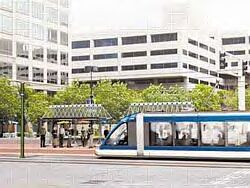
Light Rail Now! can be contacted at: |
In a stunningly positive editorial (below), the Kansas City Star has conferred a powerful and eloquent endorsement of Kansas City's proposed light rail transit (LRT) project. This endorsement by Kansas City's leading mainstream newspaper not only gives an obvious boost to the LRT campaign effort in KC, but also provides a succinct distillation of some of the most compelling arguments for LRT, anywhere. It's worth highlighting some of the editorial's more salient points. Noting that "Light rail is a remedial strategy not just for transportation but, even more important, for city development", the Star notes that LRT could help to repair such problems as the city's "fragmented development pattern and a downtown that is far less vibrant and exciting than it could be." it further notes that "A major contributing factor has been the network of urban freeways that carved up parts of the central city and severed downtown's ties to close-in neighborhoods" – a circumstance that could just as well apply to dozens of cities across North America. The Star also deals cogently with the issue of LRT's cost:
In focusing on how LRT "would help reknit the urban fabric while linking some of Kansas City's major activity centers", the Star could not be more on target. As the paper points out, a key role of LRT is not just to solve mobility challenges, but to help fashion a more livable urban environment:
In contrast, by bringing attention to the problem of parking – i.e., the cost and spatial requirements of simply storing the overwhelming numbers of vehicles needed in the private-automobile-dependent system – the Star throws a limelight on an additional mobility problem, over and above the issue of congestion alone:
While LRT, like all major transportation projects, is expensive, says the Star, it stands out as a prudent investment in the city's future:
Whatever happens in Kansas City in August 2001, those are powerful and compelling reasons why LRT will continue to inspire hope, motivate civic enthusiam, and emerge and flower in one city after another.
13 July 2001 Editorial Light rail plan deserves public support On Aug. 7 Kansas City voters will decide whether to approve a 25-year, half-cent sales tax to help finance a $793 million light-rail system. If built, this would be one of the biggest public-improvement projects in the city's history – and it could represent a turning point in the development of Kansas City's urban core. Light rail is a remedial strategy not just for transportation but, even more important, for city development. Kansas City has often scattered its public assets, a policy that led to a fragmented development pattern and a downtown that is far less vibrant and exciting than it could be. A major contributing factor has been the network of urban freeways that carved up parts of the central city and severed downtown's ties to close-in neighborhoods. With all of the attention that light rail's critics are focusing on its high cost, it should be pointed out that the construction and maintenance of these freeways – along with the costs of smaller roads throughout the metropolitan area – were and will continue to be extremely expensive as well. The question is not whether our society will provide massive public subsidies for transportation; the question is which forms of transportation will receive the most government support. The proposed light-rail system would help reknit the urban fabric while linking some of Kansas City's major activity centers. The proposed Troost Avenue line would connect institutions at the Hospital Hill complex with others at or near Rockhurst University, including the University of Missouri-Kansas City, the Stowers institute and the Kauffman Foundation. Several blocks to the west, rails on Main Street would link the Country Club Plaza, Crown Center, Union Station and downtown. The line would continue north, adding another pathway through the transportation choke point of the Missouri River, and terminating at a major park-and-ride lot in the Northland. As in other cities where rail transit has been built, the system proposed for Kansas City will help spur pedestrian-friendly development, especially near light-rail stations. Over the years it will profoundly change the look of the city.
How? Rail attracts more riders than buses; from the perspective of many businesses, it can function as an extremely effective customer delivery system. More pedestrian traffic means more opportunities for commercial development as well as multifamily housing near the rail stations -- and a development pattern with less space set aside for the economic dead weight of parking. Reducing the need for parking is key. No city can revive itself by trying to imitate the development pattern of the suburbs. Obviously, light rail will be a costly endeavor. Yet it is not as though a half-cent sales tax will break the city. Kansas City residents have repeatedly passed half-cent sales taxes over the years for capital improvements, and other half-cent sales taxes have financed such things as education and the renovation of Liberty Memorial. And in late 1999, voters passed a full one-cent sales tax for more capital improvements. A half-cent sales tax for a mass transit system that could help reduce congestion, foster commercial development in key areas and revitalize the city seems to be not just affordable but one of the best investments that Kansas Citians can make in their future. The decision next month will not be simply about whether to approve a transportation plan. It will be a decision about what kind of city we want to build and whether it is time to balance our region's many thriving suburbs with a dynamic urban core. Rev. 2001/07/14
|
|
|
|